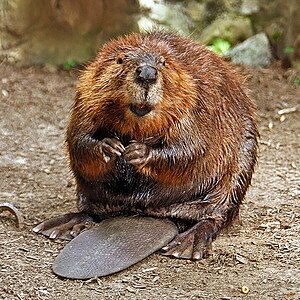 Image via Wikipedia Image via Wikipedia |
| Great new team member or a potential source of terror and rabies? |
How? New employees can get antsy. Our culture delivers instant gratification in so many ways: instant messages, on demand entertainment, personalized learning experiences, customized jeans. New recruits wonder, "Why can't I get instant results at work? I have a great idea that could save this place thousands/millions of dollars. And I've only been here a few weeks; why doesn't everyone else see it?"
Eager beavers bring fresh energy and ideas that at first glance, could generate thousands, if not millions, of dollars in increased productivity, new opportunities, and cost savings. Leadership, however, must be thoughtful before implementing new ideas. Balancing great ideas with due diligence and proper governance can be a challenge for any growing organization or one that is undergoing a significant change. Eager beavers often don't realize that building a dam at one location might improve the resources and depth of one line of business, but can dry out systems and revenue sources downstream. Each idea should be evaluated for effectiveness in the organization as a whole. And, more importantly, those ideas - and the talent - must fit with your Strategy String
- Start with a trial period. All new people, including those who have been promoted or moved into new roles, should be given a trial period in which to demonstrate consistent performance. Trial periods also give new team members time to learn and understand culture, stakeholders, and direction. On his first day, make it clear how long the trial period lasts. Define what happens at the end of the trial: what if the employee cannot meet expectations? What additional responsibilities does he gain with successful completion of the trial period? Set a time frame that allows for the eager beaver to learn the needs of his position and that allows the manager to see if he can meet expectations and fit with the culture. The greater the role that person will take on in the organization, the longer the trial period. The last thing you want is a team member who doesn't play well in the swimming hole with others and constantly misjudges the depth of the stream.
- Set clear, realistic expectations. When on-boarding any new team member, establish minimum expectations for him to meet. If these expectations differ in any way from the job description used to recruit him, point out those differences. If expectations can change over time, point out how they will change and how they will impact his career. Managers should also be asking if the minimum expectations are realistic for one person to take on. If you set the bar too high, you guarantee that your talent will fail. Don't let good beavers spend all their time swimming upstream: they can get tired and drown if they don't find another organization's stream first.
- Measure performance each day. Can the eager beaver meet expectations and meet them consistently? Effective performance by anyone in your organization (new or old, eager or resigned) is measured by how well they consistently meet expectations each day. Exceeding expectations is inappropriate if employees fail to meet minimum expectations. Document how well the eager beaver meets minimum expectations, and ask her to document her performance as well. Check in at least every two weeks with her to compare notes on performance. Are expectations being met 100% of the time? If not, should her responsibilities be revised? Or does she lack the capacity to meet the baseline expectations needed for the role? Beavers who cannot swim should not be in the stream.
- Link great ideas to your Strategy String
. Ideas are only great if they have the ability to relate. A Strategy String ties culture, stakeholders, and direction to performance. Eager beavers should be able to demonstrate an understanding of culture, stakeholders, and direction so that they generate ideas that are meaningful to your organization. Without this understanding, ideas are created in a void, without understanding of stakeholder concerns and market forces. Eager beavers and their supervisors can waste a lot of time living in the land of possibilities while real opportunities pass them by. Don't let eager beavers divert you into shallow streams and sewer pipes.
- Translate great ideas to performance-driven actions. When the eager beaver demonstrates that she can consistently meet minimum expectations and link ideas to your Strategy String, reward her with the opportunity to put those ideas into action. If she has a great idea for a new injection molding process and can keep up with minimum expectations, accommodate her by making the talent, space, funding, and other resources available to pursue the concept. Set a deadline by which she should present the results and demonstrate how the new idea will deliver long-term positive return on investment. If the candidate can translate the idea into sustainable, performance-driven actions, let her manage or lead the idea. If not, ask that the idea is not pursued further, and encourage her to come up with more great ideas to test in the future. Don't let eager beavers get discouraged: promote creativity and innovation.


